By Gwendolyn Seale
Last week, participants in Phonorecords IV filed the public versions of their written direct statements with the Copyright Royalty Board (CRB) – and since, countless articles have surfaced from the major music media outlets with headlines reading, “Streaming Services Propose Lowest Rates in History for Songwriters”(see here: https://www.musicbusinessworldwide.com/spotify-and-other-streaming-services-propose-lowest-royalty-rates-in-history-for-songwriters/) and tuneful soundbites equating this proceeding to a “war” (Id).
It is absolutely accurate that the streaming services are pushing for abysmal rates and terms in Phono IV. Some services like Amazon, Pandora and Spotify actually advocate to a return of the rates and terms from prior rate setting “wars” in Phono I (2006) and II (2011). Others, like Apple, suggest applying the rates and terms that are determined by the CRB in Phono III – which, mind you, covers 2018-22, and is being litigated simultaneously despite 2022 commencing in two months – because what an awesome system is this Copyright Royalty Board! Nevertheless, there is something that has been conveniently omitted from each of these media articles: “the why.” Why are the services proposing the “lowest rates in history?” What justification do the services provide for their positions? Unfortunately, the answer is not as simple as the streaming services playing the role of “the villains” in the “war” for songwriters’ livelihoods.
When you download the hundreds of pages of the services’ written direct testimony from the CRB, and wade through the arguments in the mire of heavily redacted passages, there is a surprising common theme used to bolster every last one of their positions: the proposed settlement by the NMPA, NSAI and the three major labels to freeze rates for physical product like vinyl and permanent downloads (the Subpart B configurations) (see here: https://app.crb.gov/document/download/25288).
Simply put, every service used the NMPA and NSAI proposed settlement for physical as a benchmark to support their abysmal rates on streaming. Surprised? Me, too. But for reference I’ve included some excerpts from the services’ filings at the end of this post.
For those in need of catching up to this point, The Trichordist has chronicled this proposed settlement and the reactions thereto (i.e. “the Frozen Mechanicals Crisis” see here: https://thetrichordist.com/category/frozen-mechanicals/ ). Songwriters, music publishers, and songwriter advocates penned articles for The Trichordist and some wrote comments to the CRB objecting strongly to the NMPA and NSAI settlement. Some also wrote their representatives in Congress, expressing their dismay over this important revenue stream being frozen yet again for another five years due to a private settlement between “willing buyers” and “willing sellers” who are one and the same person at the corporate level. What’s more, Texas Congressman Lloyd Doggett submitted a letter to the Librarian of Congress and the Register of Copyrights inquiring about the matter (see here: https://thetrichordist.com/2021/07/18/letter-from-congressman-lloyd-doggett-about-frozen-mechanicals-to-librarian-of-congress-and-register-of-copyrights/).
Now that it is crystal clear the proposed settlement is being seized upon by the services as a way to benchmark and justify their lower-than-ever rate proposals (also called “hoist with your own petard”), it is time for the highly paid representatives of the copyright owners in this proceeding to truly rethink their strategies. This result was predictable – as I mentioned in my last post here: https://thetrichordist.com/2021/06/25/guest-post-by-sealeinthedeal-a-foreseeable-result-of-the-phonorecords-iv-private-settlement-opening-pandoras-box/ , “[i]t did not take a soothsayer to foresee this result; the private settlement opened Pandora’s box – begetting misery for every songwriter.”
More disturbing, they should have seen this coming a long way off because they got called out for doing essentially the same thing in Phonorecords III. For context, when there was a lull in the pace of Phono IV, I began delving through the filings in the Phono III remand. Much to my unsurprise, an expert witness for Pandora in that proceeding, Professor Michael Katz, foreshadowed the current debacle. Not only did he use the physical settlement to make the case that the streaming mechanicals rate in the 2012 settlement was a ’good benchmark,’ but also, even more disastrously, used this argument to rationalize the 2012 rate being too high in testimony filed on April 4, 2021. Chris Castle referred to this issue as the “Streaming Royalty Backfire:
“If you want to argue that there is an inherent value in songs as I do, I don’t think freezing any rates for 20 years gets you there. [Physical mechanical rates were first frozen at 9.1¢ in 2006.] Because there is no logical explanation for why the industry negotiators freeze the rates at 9.1¢ for another five years, the entire process for setting streaming mechanical rates starts to look transactional. In the transactional model, increased streaming mechanicals is ultimately justified by who is paying. When the labels are paying, they want the rate frozen, so why wouldn’t the services use the same argument on the streaming rates, gooses and ganders being what they are? If a song has inherent value—which I firmly believe—it has that value for everyone. Given the billions that are being made from music, songwriters deserve a bigger piece of that cash and an equal say about how it is divided.”
Chris Castle
The proposed settlement did not just open Pandora’s Box, it also opened Spotify’s, Google’s, Amazon’s and Apple’s boxes (don’t mind me, I’m Greek and enjoy every opportunity to make mythology references). So, when posed with the question, “why advocate for this settlement to freeze,” even following the filings of the services, the NMPA’s David Israelite provides the following commentary (heard most recently during last Wednesday’s Town Hall via zoom):
(1) he refers to folks who articulate this concern as professional critics who like to blog from their couches, and that there’s a lot of misinformation going around;
(2) the NMPA has previously (as far back as Phono I) tried to press for an increase to no avail after spending millions of dollars; and
(3) the NMPA wishes to focus efforts on the streaming services as they do not wish to fight multiple fights at once and potentially risk the labels proposing an even lower than 9.1 cent rate.
To respond to this commentary — first, it is difficult to believe the major labels would propose a lower than 9.1¢ rate if the publisher negotiators did not cave if for no other reason that the willing buyer and the willing seller standard ought to work the other way, too. However, if anyone has evidence to support this “labels will screw us” rationale, please reach out to me and I will immediately withdraw that premise. Notwithstanding, even in the hypothetical event that the labels counter with a lower than 9.1 cent rate, is it not the job of the prime representative of the “copyright owners” at the NMPA and NSAI to firmly state that this rate has been frozen for nearly 20 years and no longer will “we” (including their sister publishers) stand by this? In response to the other two points, I understand that I have spent no money in these proceedings and that I do not have the resources to do much more than write about this from the couch in my apartment in Austin, Texas. But, for what it is worth, I believe that an important part of advocacy is being open to critique, listening and learning – even if it is something that you do not wish to hear.
Speaking of, the buried lede is that the CRB has reopened the public comments on the proposed settlement to freeze physical mechanicals – the CRJs are at least willing to listen and learn. Maybe they don’t think we’re couch commenters.
Now, I do not believe in presenting a laundry-list of problems without proffering potential solutions, and luckily, there is a solution that is entirely within the control of the parties that settled: withdraw the proposed settlement to freeze the mechanical rates for Subpart B configurations. Go to the labels and negotiate a voluntary increase. Submit that increase proposal to the CRB. This act will not only bring the entire songwriter and music publisher communities together, but it will also serve to extinguish one of the services’ key benchmarks in their testimony.
While we’re on the topic of strategies, I want to end on one note. Now is not the time to pit what artists are earning from digital radio in relation to what songwriters are earning ( see here: https://variety.com/2021/digital/opinion/digital-radio-guest-column-david-israelite-nmpa-1235092330/ ). One of the great things about working with songwriters in Texas happens to be that many are also recording and performing songwriter/artists. Thus, they value the rates from digital radio that are applied to recording artists, and they welcome the victory achieved by SoundExchange in Web V (which resulted in a rate increase plus index of rates in accordance with inflation — which seems wiser by the day and winter is coming).
Instead, it is time for the focus to be on achieving the best possible results in Phono IV by expanding the revenue stream, not taking money from others which only benefits the services.
THE RECEIPTS: Petard-Hoisting Excerpts from the Services’ Testimony
(Note: PDD = “permanent digital downloads,” and WBWS = the “willing buyer willing seller” standard which the Copyright Royalty Judges (CRJs) are to use as the basis for determining rates in this proceeding, pursuant to the Music Modernization Act.)
AMAZON

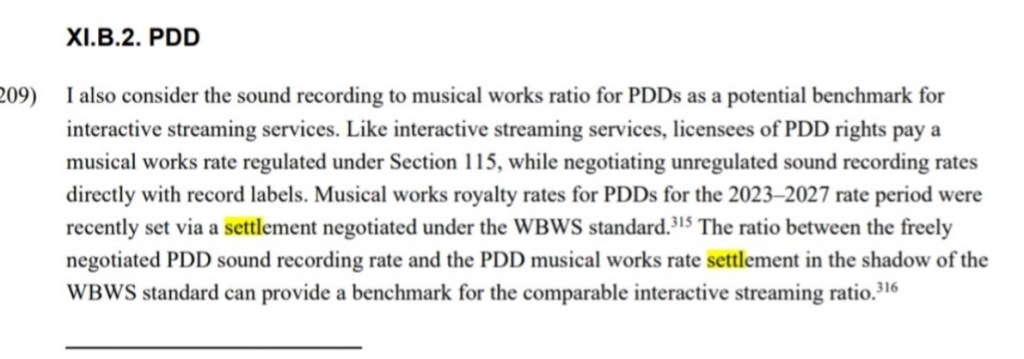
PANDORA:
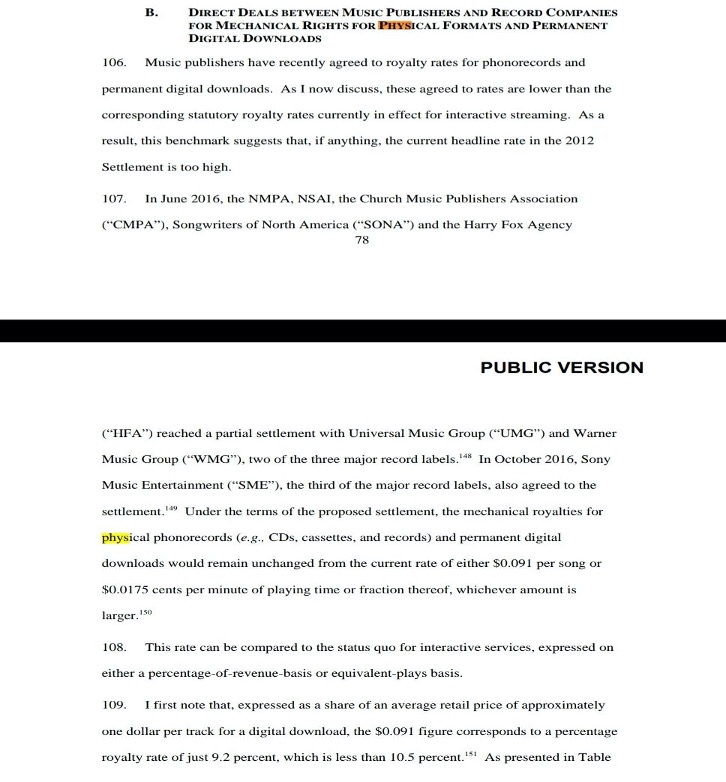
APPLE:

GOOGLE:
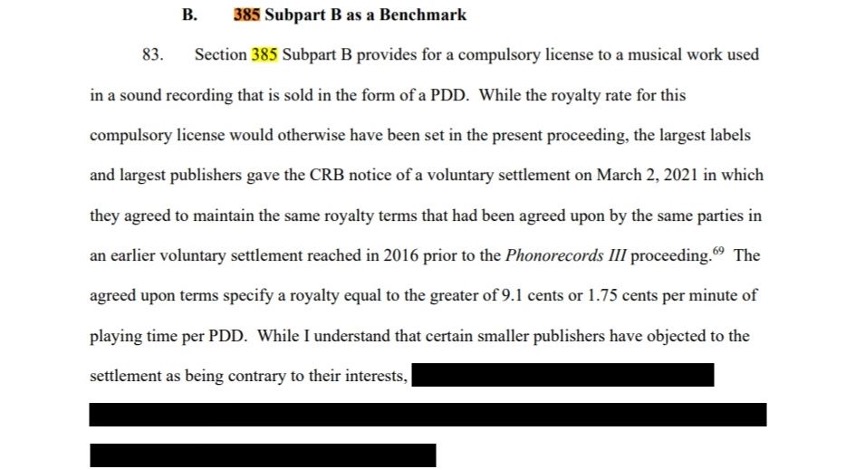
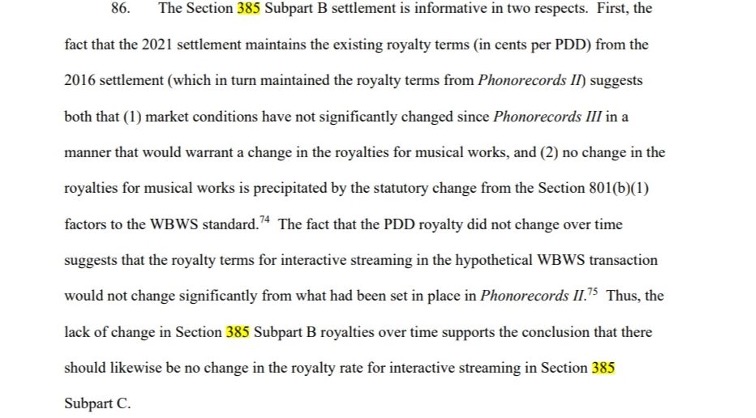
SPOTIFY:
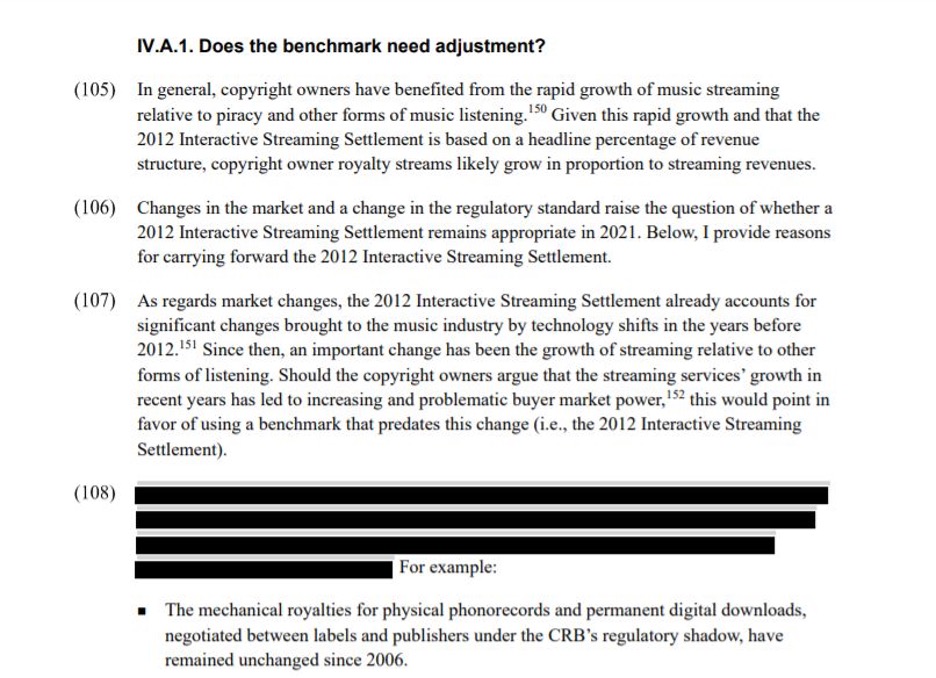

Who could possibly have imagined that the digital distribution profiteers would take the sweetheart deal engineered by NMPA, NSAI and the major labels to freeze physical and download royalty rates at 2006 levels, and use it against the music creator community by screaming “us too!”? Why, it was just impossible to predict that Spotify and its friends would claim they deserve the same treatment by the freezing and lowering of already-pathetic streaming royalty rates, wasn’t it? Despite the dozens of warnings from the US and global, independent songwriter and composer groups that this is exactly what would happen, why, everyone was understandably still taken by surprise! And who could have even guessed that a royalty rate frozen in 2006 would now be worth 40% less in 2021 than it was when established? Hmmmm.